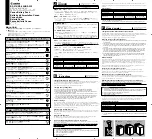
4
RADIO FREQUENCY INTERFERENCE
Radio Frequency Interference (RFI) is a phenomenon that exists in modern
society and is a problem in many areas of electronics. For users, RFI normally
presents itself in the form of static and/or interference when listening to an AM
radio and in unusual cases may interfere with TV reception.
Over the years Latronics has continued to invest significant time and effort in
the reduction of RFI related emissions from the entire product range, so that
they comply with the appropriate International and/or Australian Standards.
Even with this compliance, there are situations where RFI may still be a cause
for concern, and can differ greatly from installation to installation. Accordingly,
the following is a list of recommendations made to assist in the overall
reduction of RFI.
1.
Separate DC and AC wiring. Avoid running DC and AC cables in the same
conduits and/or cable trenches. It is strongly recommended that DC and
AC wiring be separated by the greatest distance possible. In extreme
cases, the use of shielded conduit may be necessary.
2.
Minimize length of DC cabling. DC cables can act as an aerial, therefore
all such cables should be kept as short as is practicable. For best
performance minimize DC cable length between charger and batteries and
if possible avoid the use of auxiliary DC loads.
3. 240Vac Earth. For household installations, it is recommended that a ”good”
Earth Stake is located as nearby any Charger as is possible.
4.
AM and HF Radios. These types of radio equipment inherently suffer from
all forms of RFI, especially when the received signal level is weak. In such
cases reception can sometimes be improved by relocation of the radio
itself, alternatively the use of an appropriate external antenna and co-axial
cable may be necessary. External antennas should be located in a manner
that ensures maximum signal strength whilst affording the greatest
possible distance away from the Charger and batteries.
5.
Televisions. TV signals are transmitted as FM waveforms. This type of
signal fundamentally reduces the effects of RFI, therefore the use of a
good antenna and feeder cable is normally sufficient to ensure quality
reception. Locating the television as far as possible from the Charger may
also improve picture clarity.
6.
Mobile Installations. Due to the limitations of this type of installation, the
best results for the minimization of RFI are usually obtained by maximizing
the distance between the Charger and the Radio/Television.
9
WIRING DIAGRAMS for 12 & 24 Volts DC
CHARGING STAGES
+
-
+
-
+
-
12-Volt System
24-Volt System
TIME
BOOST
ABSORPTION
FLOAT
SILENT
VO
LT
AG
E
EQUALIZE
(Every 90 days)
2 days
14 days


























